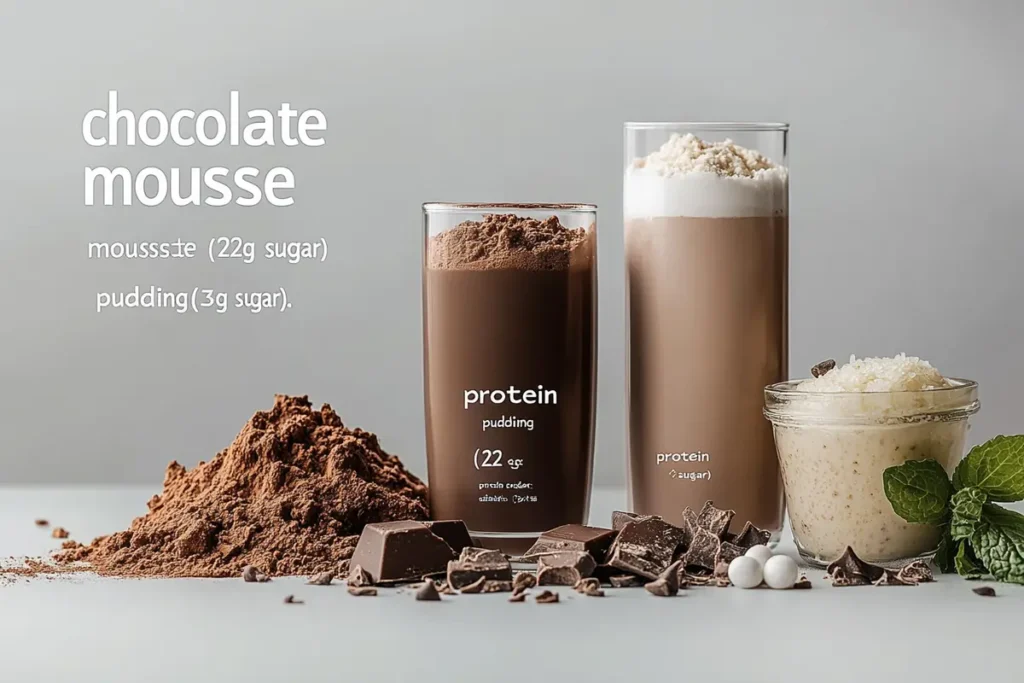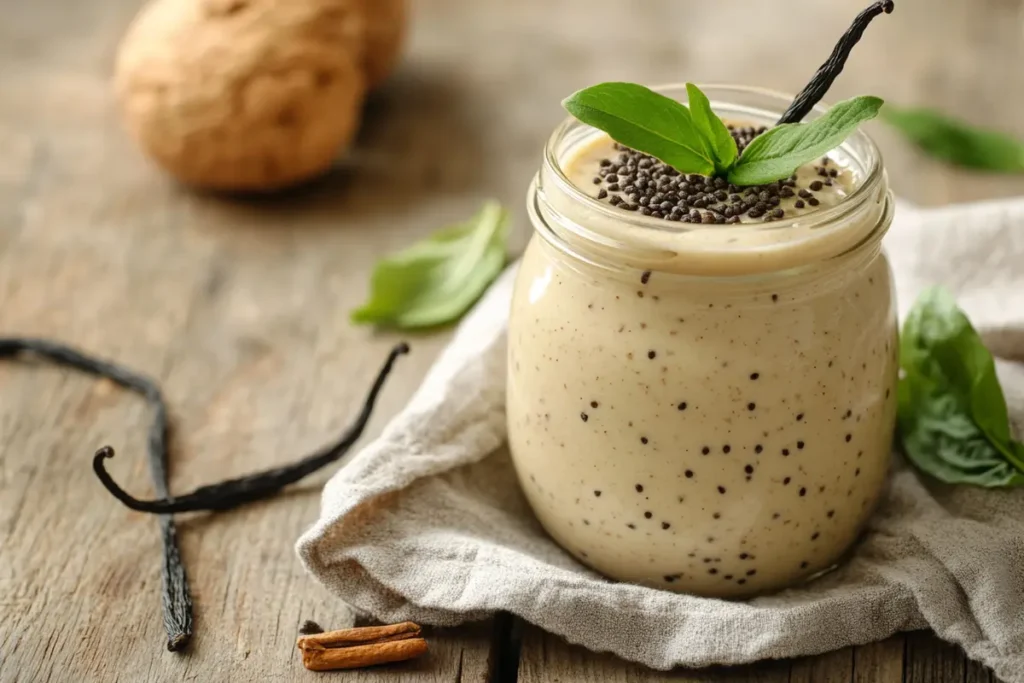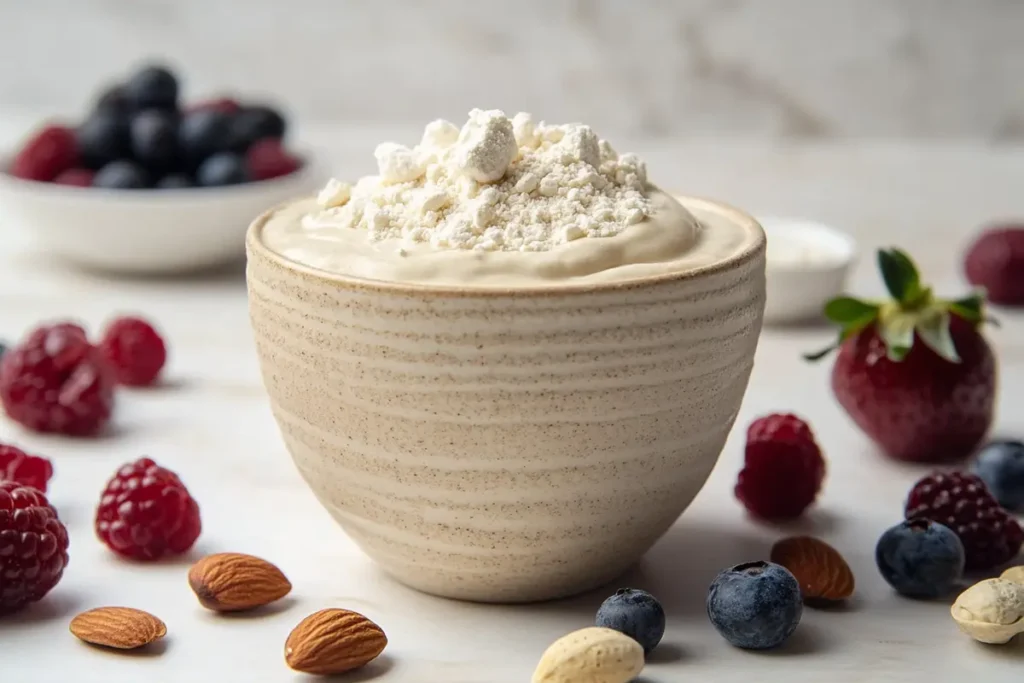Understanding Protein Puddings
Protein puddings are creamy, dessert-like snacks enriched with protein. Their main appeal lies in their ability to satisfy sweet cravings while providing a protein boost. Commonly marketed toward health-conscious consumers, they’re designed to fuel your body with added nutrients.
These puddings typically consist of a base like milk or plant-based alternatives, combined with a protein source such as whey, casein, or pea protein. Alongside that, flavors like chocolate, vanilla, and caramel are added to make them indulgent. However, it’s important to read between the lines because added sugars and artificial sweeteners are often included to enhance the taste.
Common Ingredients in Protein Puddings
What exactly goes into a protein pudding? Here’s a breakdown:
- Protein Sources: Whey isolate, casein, or vegan proteins like soy or pea.
- Sweeteners: Depending on the brand, you may find refined sugar, agave, stevia, or erythritol.
- Thickening Agents: Ingredients like xanthan gum or gelatin give puddings their smooth texture.
- Flavors and Additives: From cocoa powder to artificial flavors, these add taste but sometimes extra calories.
Some protein puddings have no added sugar, while others may contain hidden sugars such as fructose syrup or “natural sweeteners” that still spike blood sugar.
Why Is Protein Added to Desserts?
Protein helps increase satiety, meaning you’ll feel full for longer, reducing the urge to overeat. Unlike traditional puddings, which are often heavy on carbs and sugar, protein puddings can support muscle repair after workouts. Plus, they’re convenient for people on the go—just grab a cup and enjoy!
Nutritional Profile of Protein Puddings
Nutritional Content of Protein Puddings (Per 100g Serving)
| Nutrient | Average Value |
|---|---|
| Calories | 70–140 kcal |
| Protein | 8–15 grams |
| Carbohydrates | 3–12 grams |
| Sugar | 1–7 grams |
| Fat | 1–5 grams |
| Calcium | 5–12% of daily value |
*Values may vary based on the brand and type of protein pudding (dairy-based vs. plant-based).
The macronutrient composition of protein puddings varies based on the brand and recipe. Here’s what you can generally expect in one serving (around 150g):
- Calories: 100–200
- Protein: 10–20 grams
- Carbohydrates: 5–20 grams (depending on sugar levels)
- Fats: 2–5 grams
Some options boast added vitamins like calcium and B12, especially plant-based versions. While the protein content is high, it’s crucial to keep an eye on the sugar levels—they can vary more than you’d think!
Sugar Content in Popular Protein Pudding Brands
How Much Sugar Is in Store-Bought Protein Puddings?
When you browse the aisles for protein puddings, you’ll notice a range of brands claiming to be “low-sugar” or “sugar-free.” But how low is low? Some brands keep their sugar content below 3 grams per serving, while others contain over 10 grams—which can quickly add up if you’re aiming for a low-sugar diet.
Top Protein Pudding Brands and Their Sugar Levels
Let’s take a closer look at some popular brands and their sugar content:
- Premier Protein Pudding
- Sugar content: 2 grams per serving.
- Sweeteners used: Sucralose, which is calorie-free but artificial.
- A creamy, guilt-free option often used by fitness enthusiasts.
- Koia Protein Pudding
- Sugar content: 5 grams per serving.
- Sweeteners used: Monk fruit and coconut sugar, which are considered more natural but still add sweetness.
- Oikos Pro Yogurt (Protein Pudding Alternative)
- Sugar content: 1 gram per serving (for the no-sugar-added version).
- A high-protein option with a thicker consistency.
- Jell-O Protein Pudding Cups
- Sugar content: 10 grams per serving.
- A more dessert-like option but significantly higher in sugar compared to its competitors.
Hidden Sugars and Labeling Tricks
Don’t be fooled by labels that say “no added sugar”—they may still contain hidden sugars like lactose (natural milk sugar) or maltodextrin (a starchy additive). Also, “natural sweeteners” such as honey or agave syrup, although not refined sugar, can have the same blood sugar impact.
Brands often use different names for sugars, such as:
- Fructose
- Dextrose
- Glucose syrup
- Corn syrup solids
To avoid being misled, check the total grams of sugars in the nutrition facts and scan the ingredient list for these aliases.
Comparing Sugar Levels: Regular Desserts vs. Protein Puddings

Protein puddings often claim to be a healthier substitute for traditional desserts. For context:
- Regular chocolate pudding (125g): 20–22 grams of sugar.
- Protein chocolate pudding (125g): 3–6 grams of sugar (depending on the brand).
The comparison shows that protein puddings can significantly reduce your sugar intake without sacrificing taste—provided you choose the right option.
What About Artificial Sweeteners?
Many protein puddings use artificial sweeteners like sucralose, stevia, or erythritol to keep sugar levels low. While these sweeteners have fewer or no calories, there’s ongoing debate about their long-term health effects. If you’re sensitive to artificial ingredients or prefer to avoid them, look for options that use monk fruit, coconut sugar, or other plant-based alternatives instead.
Health Implications of High Sugar Intake and Benefits of Protein Desserts
Health Implications of Consuming Too Much Sugar
Excess sugar intake can lead to a variety of health issues. While protein puddings may seem like a healthier option, those with hidden or high sugar content can still contribute to negative health outcomes. Here’s why it’s important to be mindful of your sugar intake:
- Weight Gain: Consuming sugar in excess can cause an increase in calories without providing much satiety, leading to overeating.
- Blood Sugar Spikes: Sugary desserts can cause blood glucose levels to spike and crash, leaving you feeling tired and hungry soon after.
- Risk of Chronic Conditions: Long-term high sugar consumption has been linked to an increased risk of conditions such as type 2 diabetes, cardiovascular disease, and liver issues.
- Tooth Decay: Sugar feeds harmful bacteria in the mouth, which can lead to cavities and tooth decay.
It’s clear that the amount of sugar in your diet plays a significant role in overall health—so choosing low-sugar or sugar-free protein puddings is a step in the right direction.
Why Protein in Desserts Is Beneficial
On the flip side, protein-enriched desserts come with their own benefits. Here’s why protein puddings can be a smart addition to your diet:
- Increased Satiety: Protein takes longer to digest, making you feel full longer compared to carb-heavy desserts. This can help prevent snacking and curb overeating.
- Muscle Repair and Recovery: Protein is essential for repairing muscle tissue, especially after exercise. A protein pudding post-workout can act as a quick recovery snack, or you can try a protein coffee recipe for an energizing drink..
- Balanced Energy Levels: Unlike sugar, protein provides a more stable energy release, helping to prevent those dreaded sugar crashes.
- Convenience Without the Guilt: Many protein puddings are designed to be convenient, single-serve options that fit into busy lifestyles without derailing health goals.
Low-Sugar Protein Pudding Options to Consider
If you’re aiming for a healthier treat, consider these tips when selecting a low-sugar protein pudding:
- Look for options with 5g of sugar or less per serving.
- Choose puddings sweetened with natural alternatives like stevia or monk fruit rather than refined sugars.
- Avoid versions with a long list of unrecognizable additives.
Real-Life Benefits of Replacing Sugary Desserts with Protein Puddings
Replacing traditional sugary desserts with protein puddings can help:
- Support weight loss or maintenance goals.
- Satisfy sweet cravings without the sugar crash.
- Improve post-workout recovery thanks to the protein boost.
When combined with a balanced diet, low-sugar protein desserts can make a noticeable difference in both your fitness progress and overall well-being.
Homemade Protein Pudding Recipes and Alternatives to Consider
Simple Homemade Protein Pudding Recipes
Making your own protein pudding at home is a great way to control the ingredients and cut back on unnecessary sugars. Plus, homemade versions can be just as delicious as store-bought ones. Below are a few easy recipes to try, including this protein pudding recipe.:
1. Chocolate Almond Protein Pudding
Ingredients:
- 1 scoop chocolate protein powder (whey or plant-based)
- 1 cup unsweetened almond milk
- 2 tablespoons unsweetened cocoa powder
- 1 tablespoon chia seeds (optional for thickness)
- 1 teaspoon stevia or monk fruit sweetener (adjust to taste)
Instructions:
- In a bowl, whisk the protein powder and cocoa powder with the almond milk until smooth.
- Stir in the chia seeds and sweetener.
- Let the mixture sit in the fridge for 1–2 hours until thickened.
- Serve chilled with a sprinkle of crushed almonds for extra crunch.
2. Vanilla Greek Yogurt Protein Pudding

Ingredients:
- ½ cup plain Greek yogurt (unsweetened)
- 1 scoop vanilla protein powder
- 1 teaspoon vanilla extract
- 2 tablespoons unsweetened coconut milk
- Fresh berries for topping
Instructions:
- Mix the Greek yogurt and protein powder until well combined.
- Add the vanilla extract and coconut milk to reach your desired consistency.
- Top with fresh berries for natural sweetness.
Why Make Homemade Protein Puddings?

- Control Over Ingredients: You can avoid artificial additives and hidden sugars.
- Customization: Adjust the sweetness, flavors, and textures to suit your preferences.
- Cost-Effective: Homemade puddings are often cheaper than store-bought versions.
Alternatives to Protein Puddings
If protein puddings aren’t your thing or you want some variety, consider these other high-protein, low-sugar dessert options, like this protein cookie recipe:
- Protein Smoothie Bowls: Blend frozen berries, a scoop of protein powder, and unsweetened almond milk. Top with nuts and seeds for added crunch.
- Cottage Cheese and Fruit: A simple yet protein-rich dessert. Mix plain cottage cheese with fresh fruit like blueberries or sliced strawberries.
- Greek Yogurt Parfaits: Layer plain Greek yogurt with sugar-free granola and cinnamon for a quick, satisfying treat.
- Chia Seed Pudding: Combine chia seeds, unsweetened milk, and a dash of vanilla. Let it set overnight for a creamy, nutritious dessert.
Balancing Protein Puddings with a Healthy Diet
Even with homemade and low-sugar options, moderation is key. Here are some tips for keeping your diet balanced:
- Portion Control: Stick to reasonable serving sizes to avoid over-consuming calories.
- Pairing: Combine protein puddings with fiber-rich foods like fresh fruits to aid digestion and keep you full longer.
- Avoid Processed Additives: Stick to natural sweeteners and ingredients for a cleaner dessert option.
Protein puddings, when chosen wisely, can satisfy sweet cravings without sabotaging your health goals. And with so many alternatives available, there’s always something new to try!
Frequently Asked Questions
Are Protein Puddings Suitable for Diabetics?
Yes, some protein puddings are suitable for diabetics, especially those labeled “no added sugar” or “low sugar.” These typically use sweeteners like stevia or monk fruit, which have minimal impact on blood sugar levels. However, it’s essential to read the nutrition label and avoid versions with hidden sugars or high carbohydrate content.
Do All Protein Puddings Contain Added Sugars?
No, not all protein puddings contain added sugars. Some brands prioritize using natural sweeteners or no sweeteners at all. Options like unsweetened almond milk-based puddings or homemade versions allow you to skip added sugars entirely.
How Can I Identify Hidden Sugars in Protein Puddings?
Check the ingredient list for terms like dextrose, maltodextrin, corn syrup, fructose, and cane sugar. Even if the label says “natural sweetener,” it may still be a form of sugar that impacts blood sugar levels.
Are There Vegan Options for Protein Puddings With Low Sugar?
Absolutely! Many brands offer plant-based protein puddings using pea or soy protein with low or no added sugars. Homemade versions with coconut milk or almond milk, combined with vegan protein powder, are also excellent alternatives.
Can Protein Puddings Replace a Meal?
While protein puddings can be filling due to their high protein content, they’re typically low in calories and nutrients like fiber and healthy fats. For a complete meal replacement, consider adding healthy toppings like nuts, seeds, or oats to increase the nutrient density.
Conclusion
In conclusion, protein puddings can be a fantastic addition to your diet—provided you choose wisely. By understanding their nutritional profile, sugar content, and healthy alternatives, you can enjoy these protein-packed treats without worrying about excessive sugar intake. Whether you opt for store-bought brands or create your own at home, there’s a protein pudding option for everyone.
Enjoy experimenting and finding the perfect blend that satisfies your cravings while supporting your health goals!

